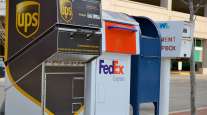Staff Reporter
UPS to Hire 30,000 Extra Drivers for Peak Season

[Stay on top of transportation news: Get TTNews in your inbox.]
UPS Inc. is set to hire more than 30,000 additional drivers for peak season, a mix of package car drivers, commercial driver license drivers and seasonal support drivers.
Atlanta-based UPS plans to hire more than 100,000 seasonal workers to meet the 2023 holiday rush, it said Sept. 26, and a representative told Transport Topics some 30% of these new workers will be drivers.
A year earlier, UPS said it would hire more than 100,000 seasonal employees ahead of the holiday rush, of which 30-35% were drivers.
UPS ranks No. 1 on the Transport Topics Top 100 list of the largest for-hire carriers in North America.

Tomé
The upcoming holiday season is more important than usual for UPS. The company shed a lot of business as a result of uncertainty around labor negotiations. UPS lost 1.2 million packages a day to rivals as a result of the concerns, CEO Carol Tomé said during the company’s second-quarter 2023 earnings presentation. UPS cut its full-year 2023 revenue guidance to $93 billion from $97 billion as a result.
Amazon.com Inc. on Sept. 19 said it planned to hire 250,000 employees in the U.S. for full-time, seasonal and part-time roles across its operations network. A company spokeswoman said Sept. 26 a breakdown of what positions would be filled was unavailable.
Amazon.com ranks No. 9 on the Transport Topics Top 100 list of the largest private carriers in North America.
The U.S. Postal Service, meanwhile, plans to hire 10,000 seasonal employees, compared with around 28,000 a year ago.
USPS’ seasonal additions were lower than usual because of the success of its Delivering for America initiative, it said, under which more than 150,000 pre-career workers transitioned into career positions since October 2020.

A U.S. Postal Service letter carrier in Atlanta. USPS plans to hire 10,000 seasonal employees. (David Goldman/Associated Press)
More of USPS’ mail and package volume will move via “improved, more reliable” ground transportation this peak season, however, instead of using more expensive air transportation, it said.
USPS ranks No. 4 on the Transport Topics Top 50 Global Freight list. UPS is No. 1 in the Global Freight Top 50. FedEx Corp. ranks No. 2 on the Global Freight Top 50 and the for-hire TT 100.
Memphis, Tenn.-based FedEx declined Sept. 26 to provide any numbers on its peak season hiring, telling TT instead: “We continue to hire for operational positions needed in certain locations and encourage anyone interested in a career at FedEx to visit careers.fedex.com to see the available positions in their market.”

Carere
During the company’s most recent earnings call Sept. 20, however, Chief Customer Officer Brie Carere said: “We feel good about peak. And from a pricing strategy perspective, we’re committed to our strategy, which does include peak surcharges.”
“We need to invest in the network,” she added. “This is a really important time of year for us, but it’s also a really important time for our customers. And so, having that surcharge there allows us to flex the network, deliver great service and then we’ll wind it down in January.”
However, supply chain software specialist E2open said the expectations are that 2023 will see another muted peak season as shippers will be watching inventory levels closely to avoid the overstocking that happened in 2022.

Gragg Wilson of UPS won grand champion honors at the National Truck Driving Championships. Wilson takes us through the competition's course, successful driving practices and how to attract new drivers. Tune in above or by going to RoadSigns.ttnews.com.
Also, consumer spending levels may not be a great deal different than those of 12 months ago in the upcoming holiday season, according to research by third-party logistics provider Kenco Logistics released in August.
About 58% of consumers expect to spend the same amount compared with the 2022 peak season, while 52% see no change in their supply chain concerns, Kenco said, adding that 54% of consumers are doing more than 60% of their holiday shopping online.
USPS said Sept. 19 that it would not levy any further peak surcharges for customers for the first time since 2019. Amazon also said its peak fulfillment fees would remain unchanged.
FedEx updated its surcharges for the period starting Oct. 9 on Aug. 29 for customers who ship more than 20,000 residential and FedEx Ground Economy packages. The calculation is based on their weekly average between June 5 and July 2.
If a FedEx customer’s shipments are between 105% and 125% of the average, then the delivery surcharge is $1.35 per package for FedEx Ground and $2.40 for FedEx Express. At the top end of the spectrum, if shipments are more than 400% of the average, the surcharge is $6.35 for FedEx Ground and $7.40 for FedEx Express.
UPS’ surcharges largely match those of FedEx and have not changed since last year. If a customer’s shipments are between 105% and 125% of the average, then the SurePost or UPS Ground Residential surcharge is $1.35 per package and $2.40 for Next Day Air Residential and all other UPS Air Residential packages.
Want more news? Listen to today's daily briefing below or go here for more info:




